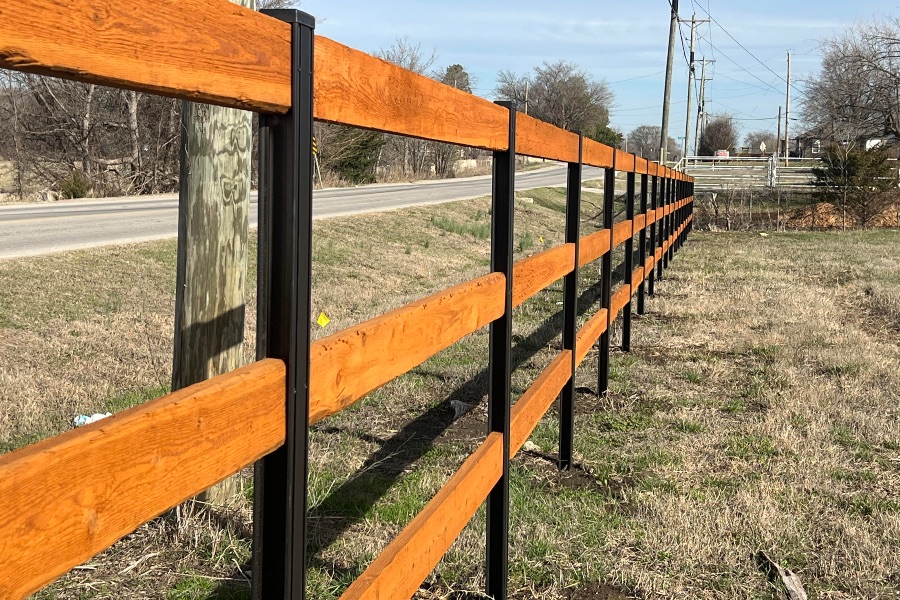All Categories
Featured
Your fencing is revealed to different weather condition conditions year-round, and while it acts as an important part of your home, it's also among the most vulnerable components when it pertains to weather-related damage. Extreme winds, heavy rain, extreme temperatures, and UV direct exposure can all take a toll on your fencing's stability, leading to damage. There are a few steps you can take to protect your fencing and extend its life-span. Below are some efficient techniques to guard your fence from weather-related damages.
Wood Fences: While timber is a traditional choice for secure fencing, it is susceptible to rot, warping, and pest damages, particularly in locations with high dampness. Pressure-treated timber or cedar is more sturdy, but regular upkeep is vital to keep it in good problem. Vinyl Fencing: Plastic is an outstanding choice for those seeking a low-maintenance and weather-resistant fencing. It's resistant to wetness, will not warp or fracture in the warmth, and resists fading from UV rays. Steel Fencing: Wrought iron and aluminum are long lasting products for fence, however they call for a rust-resistant layer to secure them from deterioration because of moisture. A protective layer or normal maintenance can prevent rust and expand the life of metal fences. Composite Fence: Made from a blend of wood fibers and plastic, composite fencings are highly immune to weather elements, consisting of moisture, warmth, and UV rays. This product offers an equilibrium of durability and visual appeal. Picking a material fit to your climate will certainly provide much better protection for your surround the lengthy term.
Seal or Discolor the Timber: Applying a high-quality sealer or tarnish to your wood fence creates a water resistant barrier that prevents moisture from entering the wood. It additionally assists secure the wood from UV rays, which can create staining and drying out. Reapply Sealer Consistently: Over time, the protective obstacle of your sealant or discolor can use down. Depending upon your environment, it's a great concept to reapply every one to two years to keep the wood shielded. This treatment will maintain the fence's appearance, protect against rot, and lengthen its life expectancy.
![]()
For additional protection, consider using wind-resistant mesh screens or panels in locations where wind is a considerable concern. This added layer can aid lessen the pressure that the wind exerts on your fencing.
Examine Drain: Make certain that the ground around your fencing slopes far from the articles. Correct drainage allows water to stream far from the fence, stopping moisture buildup. Mount Drain Solutions: In areas where drain is a worry, think about including a French drain or gravel around the base of your fencing posts to reroute water far from the framework. Great water drainage can avoid rot, corrosion, and other forms of weather-related deterioration.
![]()
![]()
Concrete Footings: Set fence posts in concrete to avoid them from loosening with time as a result of dirt erosion or shifting ground. Metal Braces: Adding steel dental braces to fence messages can provide extra stamina and minimize the danger of leaning or breaking. Strengthening your posts guarantees that your fencing will certainly remain in area, also throughout extreme weather condition.
For wood fences, carefully clean the surface area with a moderate detergent to eliminate dust and grime. For vinyl fencings, use a soft towel and cleaning solution to stop accumulation. For steel fencings, evaluate for rust and sand it off prior to applying a fresh layer of paint. Conclusion. Your fencing is an essential feature of your residential or commercial property, and with the right treatment, it can stand up to the challenges posed by the climate. By choosing resilient products, executing routine upkeep, and enhancing powerlessness, you can secure your fence from the components and prolong its life. Regular inspections, using safety coverings, and taking actions to control moisture and wind exposure will certainly aid make sure that your fence stays solid, useful, and appealing for many years to find.
- Select Weather-Resistant Products. The products you pick for your fence can have a significant influence on its capacity to withstand the components. Different materials are much better outfitted to deal with details weather. Here's a breakdown of just how numerous products stand up versus the weather:
Wood Fences: While timber is a traditional choice for secure fencing, it is susceptible to rot, warping, and pest damages, particularly in locations with high dampness. Pressure-treated timber or cedar is more sturdy, but regular upkeep is vital to keep it in good problem. Vinyl Fencing: Plastic is an outstanding choice for those seeking a low-maintenance and weather-resistant fencing. It's resistant to wetness, will not warp or fracture in the warmth, and resists fading from UV rays. Steel Fencing: Wrought iron and aluminum are long lasting products for fence, however they call for a rust-resistant layer to secure them from deterioration because of moisture. A protective layer or normal maintenance can prevent rust and expand the life of metal fences. Composite Fence: Made from a blend of wood fibers and plastic, composite fencings are highly immune to weather elements, consisting of moisture, warmth, and UV rays. This product offers an equilibrium of durability and visual appeal. Picking a material fit to your climate will certainly provide much better protection for your surround the lengthy term.
- Regularly Treat Wood Fencings. If you have a wooden fence, safeguarding it from temperature, wetness, and sunlight fluctuations is essential. Wood can absorb wetness from snow, rain, or humidity, causing it to rot and degrade. Here's just how you can safeguard wood fencings:
Seal or Discolor the Timber: Applying a high-quality sealer or tarnish to your wood fence creates a water resistant barrier that prevents moisture from entering the wood. It additionally assists secure the wood from UV rays, which can create staining and drying out. Reapply Sealer Consistently: Over time, the protective obstacle of your sealant or discolor can use down. Depending upon your environment, it's a great concept to reapply every one to two years to keep the wood shielded. This treatment will maintain the fence's appearance, protect against rot, and lengthen its life expectancy.

- Mount Windbreaks. Solid winds can trigger significant damage to fencings, particularly those constructed from light-weight materials or high structures. Wind can fall a fencing or create panels to shift. Setting up a windbreak is an efficient method to lower the effect of gusty winds. You can develop a windbreak by planting bushes, trees, or tall plants near your fence. These all-natural barriers can aid disperse wind, stopping straight gusts from damaging your fencing.
For additional protection, consider using wind-resistant mesh screens or panels in locations where wind is a considerable concern. This added layer can aid lessen the pressure that the wind exerts on your fencing.
- Ensure Appropriate Drain Around Your Fencing. Standing water is one of the leading root causes of fence damage, especially for wooden fences. Water can weaken the fencing articles, triggering them to rot and weaken faster. To avoid this:
Examine Drain: Make certain that the ground around your fencing slopes far from the articles. Correct drainage allows water to stream far from the fence, stopping moisture buildup. Mount Drain Solutions: In areas where drain is a worry, think about including a French drain or gravel around the base of your fencing posts to reroute water far from the framework. Great water drainage can avoid rot, corrosion, and other forms of weather-related deterioration.

- Trim Overhanging Branches and Vines. Trees and plants near your fencing may appear like an ornamental addition, but they can pose dangers when left uncontrolled. Looming tree branches and vines can cause damage to your fence throughout tornados or high winds. Additionally, creeping plants can trap moisture versus wooden fencings, accelerating the decaying procedure. To secure your fencing, trim any branches or plants that hang over or near the fencing frequently. This will certainly decrease the chance of dropping particles and stop wetness buildup.
- Reinforce Fencing Posts. The security of your fencing mainly relies on the condition of the blog posts. Fencing articles are vulnerable to shifting, leaning, and decomposing, specifically during periods of severe weather. If your fence remains in an area that freezes or experiences high winds during wintertime, it is very important to enhance the posts to maintain security. Some methods to reinforce your fence blog posts include:

Concrete Footings: Set fence posts in concrete to avoid them from loosening with time as a result of dirt erosion or shifting ground. Metal Braces: Adding steel dental braces to fence messages can provide extra stamina and minimize the danger of leaning or breaking. Strengthening your posts guarantees that your fencing will certainly remain in area, also throughout extreme weather condition.
- Routine Assessments and Upkeep. Check your fence after tornados or hefty rain to look for concerns such as loosened boards, drooping posts, or rusted areas. In addition, cleansing your fence periodically assists maintain its condition.
For wood fences, carefully clean the surface area with a moderate detergent to eliminate dust and grime. For vinyl fencings, use a soft towel and cleaning solution to stop accumulation. For steel fencings, evaluate for rust and sand it off prior to applying a fresh layer of paint. Conclusion. Your fencing is an essential feature of your residential or commercial property, and with the right treatment, it can stand up to the challenges posed by the climate. By choosing resilient products, executing routine upkeep, and enhancing powerlessness, you can secure your fence from the components and prolong its life. Regular inspections, using safety coverings, and taking actions to control moisture and wind exposure will certainly aid make sure that your fence stays solid, useful, and appealing for many years to find.
Latest Posts
Find Out Reduce Expenses on Car Maintenance with Montclare Auto Repair’s Limited-Time Deals
Published May 31, 25
1 min read
Explore Special Auto Repair Deals in Chicago at Montclare Auto Repair
Published May 30, 25
1 min read
Discover the Premier Auto Repair Offers in Montclare, Chicago
Published May 25, 25
1 min read
More
Latest Posts
Find Out Reduce Expenses on Car Maintenance with Montclare Auto Repair’s Limited-Time Deals
Published May 31, 25
1 min read
Explore Special Auto Repair Deals in Chicago at Montclare Auto Repair
Published May 30, 25
1 min read
Discover the Premier Auto Repair Offers in Montclare, Chicago
Published May 25, 25
1 min read